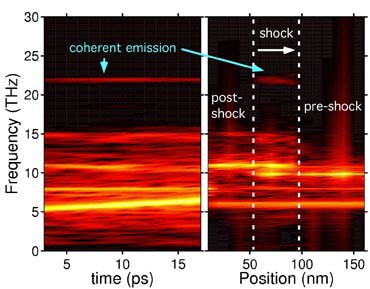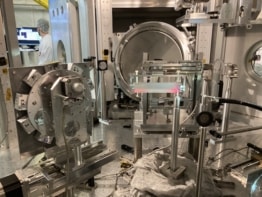Apart from lasers and free-electron lasers, there has not been a new way of producing coherent light for nearly half a century. Now, physicists in the US have found that coherent electromagnetic radiation can be generated in crystalline materials when they are subjected to a shock wave. The technique, which generates light in the terahertz region (1012Hz), could provide a new tool for determining the properties of crystals (Phys. Rev. Lett. 96 013904).

Coherent light has a very narrow bandwidth and consists of photons that are all in phase with one another. Until now, however, all practical coherent light sources have been either lasers (which were invented in 1958) or free-electron lasers, which harness the radiation emitted by relativistic electrons. The new light source, proposed by Evan Reed and colleagues at the Massachusetts Institute of Technology and the Lawrence Livermore National Laboratory, is fundamentally distinct from these sources.
Using the Thunder parallel computer at the Lawrence Livermore Lab, the researchers performed a series of theoretical calculations and experimental simulations to observe what happens when a mechanical shock wave is generated inside a dielectric crystalline material, such as sodium chloride. They expected to observe only incoherent photons and “sparks” to be produced from the crystal, but to their surprise the researchers found weak yet measurable coherent light emerging from it with a frequency between one and 100 THz
According to the team, the shock wave makes large numbers of atoms in the crystal move in a synchronized way as it propagates through the lattice. This induces an oscillating dipole-like polarization in the material that produces the coherent radiation observed. The frequency of the emitted light is determined by the speed of the shock wave and the periodic lattice structure of the crystal, and not by the coherence of the source that generates the shock wave.
“To our knowledge, coherent light never has been seen before from shock waves propagating through crystals because a shocked crystal is not an obvious source to look for coherent radiation,” explains Reed. “The light and radiation was in a portion of the electromagnetic spectrum that is not usually observed in these types of experiments.”
The researchers say that the effect should be observed in a wide variety of crystalline materials, and plan to perform experiments to observe coherent radiation in the laboratory. Among a diverse range of potential applications, coherent light from a shocked crystal could be used as a diagnostic tool to determine atomic-scale properties of the shocked material.


